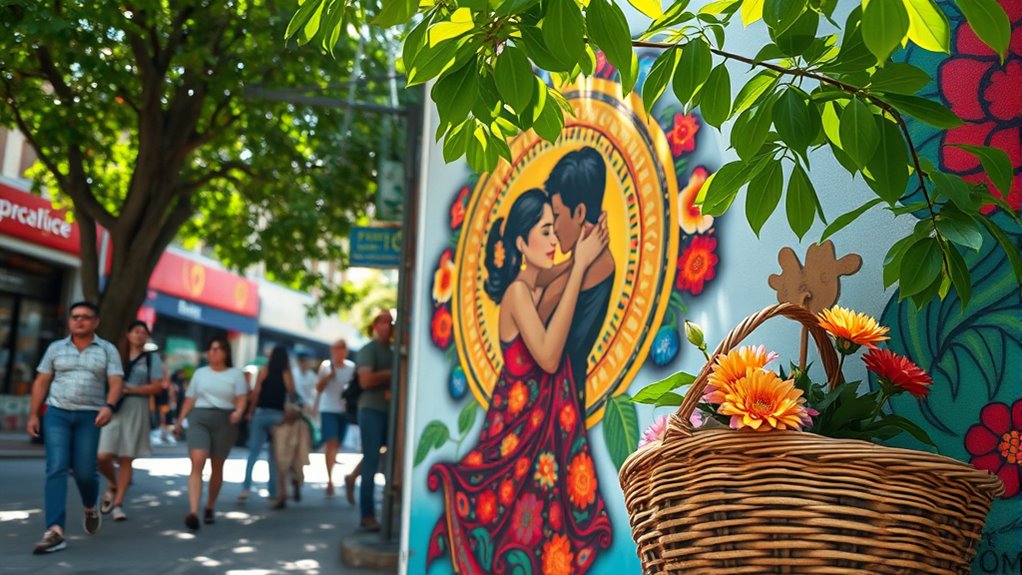Filipino art vividly embodies relationship values like family loyalty, respect, and community ties. Through depictions of familial unity and traditional courtship, artists showcase the significance of supportive bonds in romantic pursuits. Whether it’s the playful teasing in courtship or the deep reverence for elders, these artworks highlight the cultural narratives that shape connections. By exploring these themes, you’ll uncover even more about how art reflects the essence of Filipino relationships.
Key Takeaways
- Filipino art often depicts family unity, illustrating the strong bonds and support systems that shape relationship values in the culture.
- Artists like Fernando Amorsolo capture respect for elders through traditional clothing and harmonious family scenes, reflecting cultural narratives in relationships.
- Courtship practices are artistically represented, showcasing traditional gestures like serenading and gift-giving that emphasize respect and commitment.
- Social commentaries in works by artists like BenCab highlight the importance of loyalty and respect within societal structures and relationships.
- Artistic expressions reinforce the collective strength of families, integrating cultural influences that guide romantic relationships and community interactions.
The Role of Family in Filipino Relationships
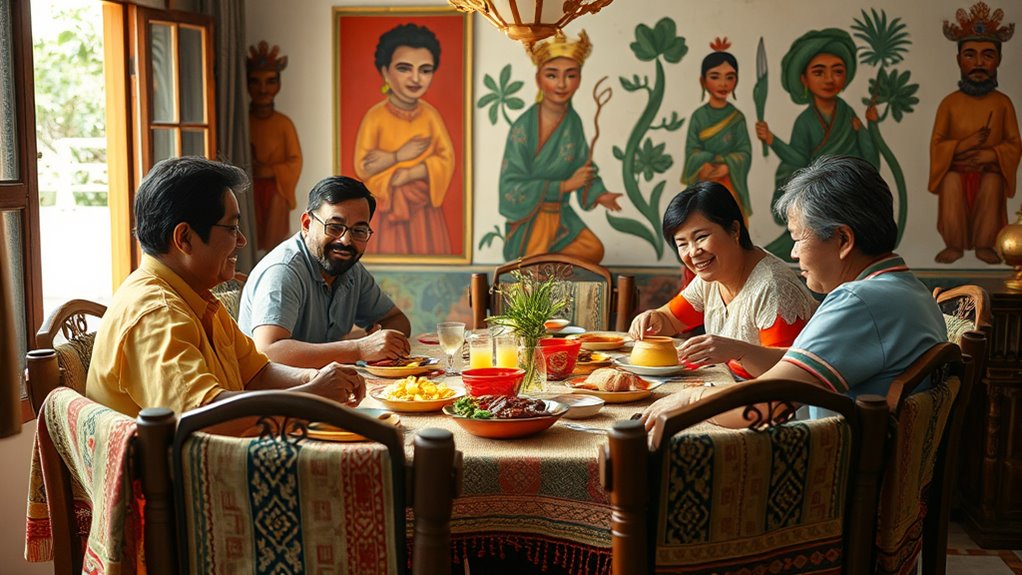
Although you might find family dynamics differ across cultures, Filipino relationships are profoundly shaped by the central role of family. In Filipino culture, family extends beyond the nuclear unit, forming a wide network of supportive relatives and close friends. This interconnectedness provides a robust support system, offering childcare and financial assistance when needed.
You’ll notice that respect for elders is deeply ingrained, influencing interactions and cultural narratives. Families often participate in celebrations and uphold traditions together, ensuring cultural continuity.
Additionally, strong family bonds foster community cohesion, creating a shared sense of identity and responsibility. Ultimately, these relationships form the foundation of Filipino society, shaping individual values and collective strength.
Courtship Practices and Artistic Depictions
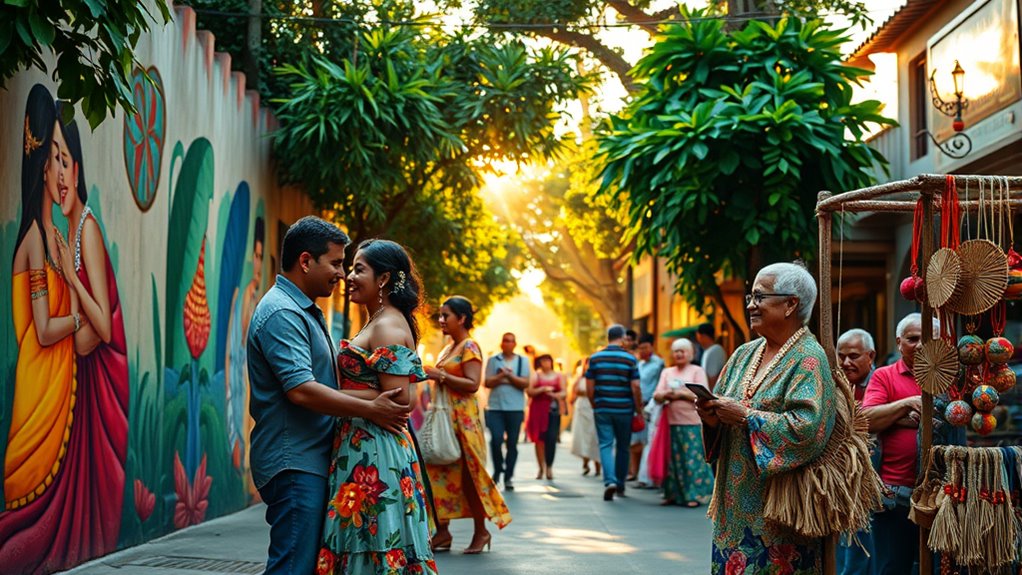
Courtship practices in Filipino culture are rich and nuanced, reflecting a blend of tradition and modernity that shapes the way relationships develop. You’ll notice that these practices often start with playful teasing, known as tuksuhan, involving friends to create a lighthearted atmosphere.
Men typically visit women at home, showcasing respectful intentions, often in the presence of family. Through acts of service, like performing household chores or paninilbihan, they demonstrate commitment.
Artistic depictions capture these moments beautifully; for instance, Vicente Manansala’s “Ang Magbabayo” illustrates men assisting women in daily tasks. Additionally, traditional gestures like serenading and gift-giving frequently appear in art, emphasizing the importance of cultural values in courtship and highlighting community involvement during these romantic pursuits.
Respect and Loyalty in Love

Respect and loyalty form the backbone of love in Filipino culture, influencing how relationships are nurtured and maintained.
Respect and loyalty are essential pillars of love in Filipino culture, shaping the dynamics of relationships.
In Filipino art, these values manifest through depictions of family unity and support, showcasing the importance of standing by loved ones. Artists like Fernando Amorsolo highlight the beauty of familial respect, often symbolized through traditional clothing and harmonious scenes.
Meanwhile, works by BenCab provide social commentary on respect within societal structures. Traditional art forms, such as wood carvings, carry motifs of loyalty and respect, reinforcing these values across generations.
As you explore exhibitions in places like the Ayala Museum, you’ll see how both respect and loyalty continue to shape the cultural narrative of love in Filipino society.
Cultural Influences on Romantic Relationships

In Filipino culture, romantic relationships are deeply intertwined with family and community influences that shape how love is expressed and nurtured.
Family involvement is vital; your loved ones often play a significant role in decision-making. You’ll find that community respect is essential, as approval from those around you can help your relationship thrive.
Traditional courtship practices, like singing love songs and giving gifts, add a unique charm to your romantic pursuits.
Family gatherings are integral to dating, allowing you to foster connections in a supportive environment.
You’ll also notice that respect for elders and adherence to societal norms guide your actions, ensuring harmony within both the family and community as you navigate love and relationships.
The Impact of Modernization on Relationship Values
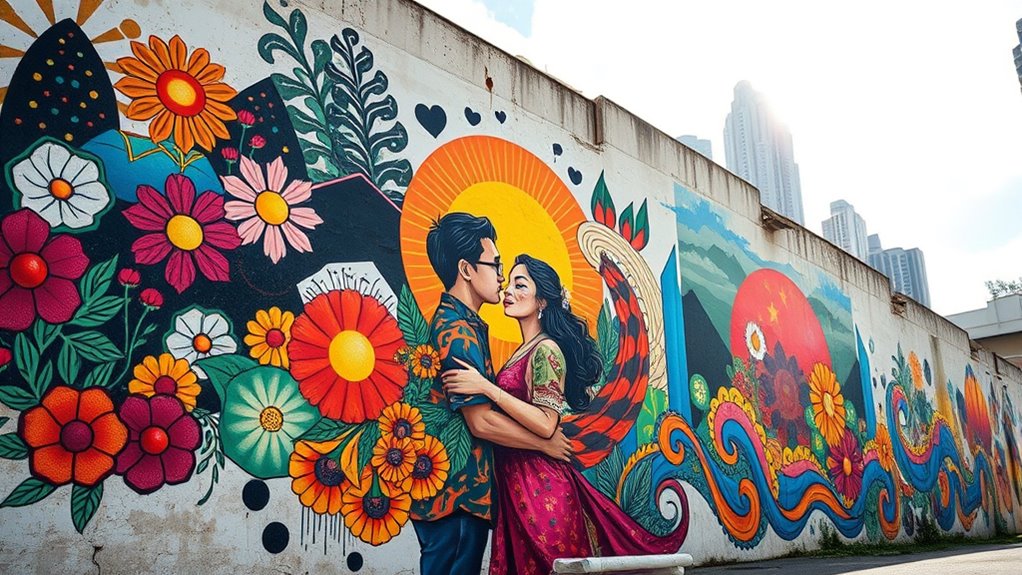
As modernization reshapes society, relationship values in the Philippines evolve, reflecting a shift toward individualism and independence.
You might notice that traditional extended families are giving way to nuclear setups, with more single-parent households emerging. Technology influences how you connect with loved ones, emphasizing digital communication over face-to-face interaction.
With a stronger focus on education and careers, you may find that family unity sometimes takes a backseat. As younger generations embrace these modern ideals, they challenge the authority of elders, leading to communication gaps.
While these changes promote financial independence, especially for women, they can also weaken traditional family support systems. Balancing these modern values with cultural heritage becomes essential for maintaining strong, meaningful relationships.
Personal Values Reflected in Filipino Art
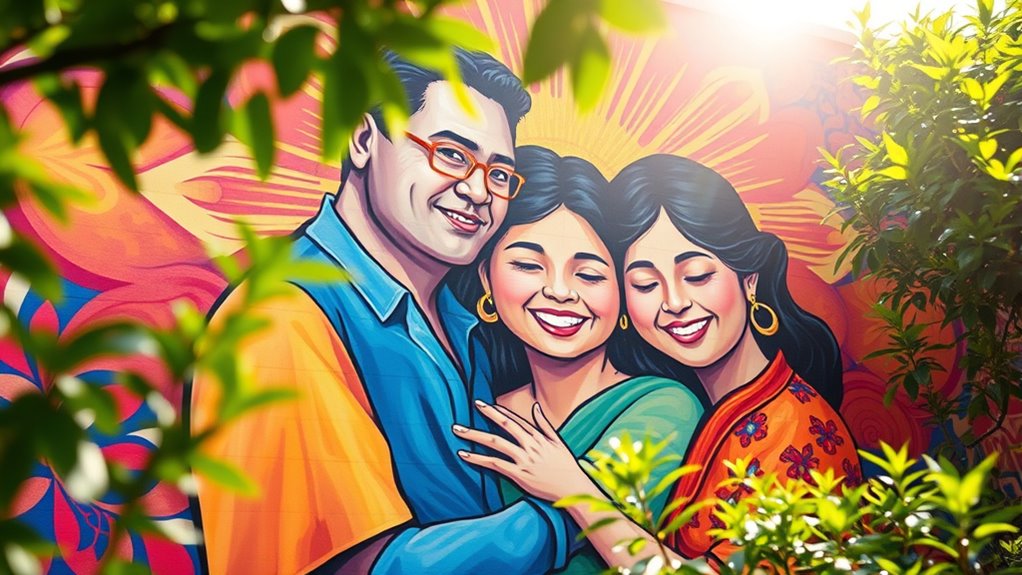
Filipino art serves as a vibrant mirror reflecting personal values deeply rooted in the culture.
You’ll notice the bayanihan spirit, showcasing unity and cooperation, often seen in artworks depicting community projects.
Family ties emerge as a central theme, with multi-generational scenes that highlight togetherness and respect for elders.
The concept of kapwa, or shared identity, is prevalent, fostering empathy and understanding among individuals.
Faith and spirituality infuse art with religious symbols, illustrating their significant influence.
Additionally, resilience shines through, as artists express optimism and humor to cope with life’s challenges.
Frequently Asked Questions
How Does Filipino Art Influence Modern Relationship Dynamics?
Filipino art influences modern relationship dynamics by encouraging emotional expression and fostering community engagement.
You’ll find that artworks often reflect societal issues, prompting discussions about social justice and personal connections. As you experience these artistic expressions, you’re inspired to innovate and adapt your own relationships, embracing creativity and resilience.
This art challenges traditional norms, allowing you to explore diverse perspectives and form deeper, more meaningful connections with others in your community.
What Materials Are Commonly Used in Filipino Art Depicting Relationships?
When you immerse yourself in Filipino art, you’ll find a treasure trove of materials that weave stories of connection.
Traditional wood carvings echo familial ties, while vibrant tapestries burst with cultural narratives. Artists may even use discarded plastic and food, transforming waste into symbols of unity.
From intricate sculptures to enchanting murals, each piece invites you to explore the rich tapestry of relationships that define Filipino culture—an artistic embrace of community and love.
How Do Regional Variations Affect Relationship Themes in Filipino Art?
Regional variations considerably shape relationship themes in Filipino art.
When you explore different regions, you’ll notice how local traditions and influences blend to create unique expressions. For instance, Cordillera art emphasizes community bonds through weaving, while Mindanao showcases Islamic motifs that celebrate diversity.
Folk festivals like Ati-atihan highlight unity and adaptation. By engaging with these regional styles, you gain a deeper understanding of how relationships are interpreted and celebrated across the Philippines.
Are There Notable Filipino Artists Focusing on Relationship Values?
Yes, there are notable Filipino artists who focus on relationship values. For instance, Fernando Amorsolo captures family and social bonds in his paintings, while Bencab explores human connections through powerful visuals.
Fernando Zóbel blends modern and traditional themes, reflecting various relationships. Mark Justiniani’s installations investigate the connections between people and their environments.
These artists showcase the depth of interpersonal relationships, emphasizing respect, commitment, and community in their work.
How Is Humor Portrayed in Filipino Art About Relationships?
In Filipino art about relationships, humor often shines through relatable scenarios, like family gatherings and love stories.
You’ll notice witty wordplay and lighthearted tones that make the artwork enjoyable. These humorous elements not only reflect cultural nuances but also create emotional connections, allowing you to bond with the characters.
Additionally, satire challenges societal norms while keeping things culturally sensitive, making the art both engaging and thought-provoking.
Conclusion
In Filipino art, you see love, you feel family, and you experience respect. It’s a vibrant tapestry woven with values that highlight the importance of relationships. As you explore these artistic expressions, you discover how tradition meets modernity, creating a rich narrative of connection and commitment. Embrace the beauty of these reflections; they remind you that at the heart of Filipino culture lies the enduring power of love, loyalty, and shared experiences.
